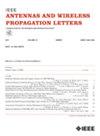基于横向共振方法的槽隙波导和衬底集成波导的统一色散关系
IF 4.8
2区 计算机科学
Q2 ENGINEERING, ELECTRICAL & ELECTRONIC
引用次数: 0
摘要
本文介绍了槽隙波导(GGWG)和衬底集成波导色散关系的统一解析模型。首先,与矩形波导类似,GGWG的主要传播模式可以解释为反射传播平面波;因此,横向共振条件在其横截面上成立。此外,我们扩展了现有的周期引脚等效阻抗模型,以考虑斜入射条件。随后,通过整合这些进展,推导出GGWG色散关系。全波仿真结果验证了该模型的有效性。具体来说,当引脚的高度与两个平行板之间的距离一致时,GGWG作为SIW起作用,并且仍然适用于所提出的分析模型。总的来说,该模型为这些波导中色散关系的电磁机制提供了一个新的视角。本文章由计算机程序翻译,如有差异,请以英文原文为准。
Unified Dispersion Relation of Groove Gap Waveguide and Substrate Integrated Waveguide Based on Transverse Resonance Method
This letter introduces a unified analytical model for the dispersion relations of both the groove gap waveguide (GGWG) and substrate integrated waveguide. First, analogous to rectangular waveguides, the dominant propagation mode in GGWG can be interpreted as bouncing propagating plane waves; hence, the transverse resonance condition holds in its cross section. Furthermore, we extend the existing equivalent impedance model of periodic pins to account for the oblique incidence condition. Subsequently, by integrating these advancements, the GGWG dispersion relation is derived. Full-wave simulation results corroborate the validity of the proposed model. Specifically, when the height of pins aligns with the distance between two parallel plates, GGWG functions as an SIW and remains applicable to the proposed analytical model. Generally, this model provides a novel perspective on the electromagnetic mechanism underlying the dispersion relations in these waveguides.
求助全文
通过发布文献求助,成功后即可免费获取论文全文。
去求助
来源期刊
CiteScore
8.00
自引率
9.50%
发文量
529
审稿时长
1.0 months
期刊介绍:
IEEE Antennas and Wireless Propagation Letters (AWP Letters) is devoted to the rapid electronic publication of short manuscripts in the technical areas of Antennas and Wireless Propagation. These are areas of competence for the IEEE Antennas and Propagation Society (AP-S). AWPL aims to be one of the "fastest" journals among IEEE publications. This means that for papers that are eventually accepted, it is intended that an author may expect his or her paper to appear in IEEE Xplore, on average, around two months after submission.

 求助内容:
求助内容: 应助结果提醒方式:
应助结果提醒方式:


